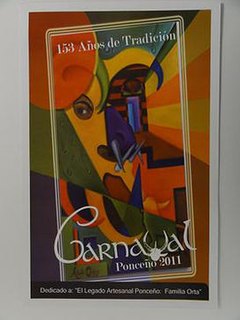Carnaval de Ponce
| Carnaval de Ponce | |
|---|---|

Poster bill of the 2011 Carnaval de Ponce, celebrated March 2–8, 2011, in Ponce, Puerto Rico.
|
|
| Official name | Carnaval Ponceño |
| Also called | Carnaval de Ponce |
| Type | Local, cultural |
| Celebrations | Parades, parties |
| Date | Week before Ash Wednesday |
| 2016 date | 3–9 February |
| 2017 date | 22–28 February |
| 2018 date | 7–13 February |
| 2019 date | 27 February - 5 March |
| Frequency | Annual |
| First time | 1858 |
| Related to | Lent |
The Carnaval de Ponce (English: Ponce Carnival), officially Carnaval Ponceño, is an annual celebration held in Ponce, Puerto Rico. The celebration lasts one week and it ends on the day before Ash Wednesday. Thus, it is generally held in February and sometimes in March. It is one of the oldest carnivals of the Western Hemisphere, dating back to 1858. Some authorities, such as the Smithsonian Institution, believe the Ponce Carnaval can be traced to as far back as 250 years ago. The Carnaval coincides with the Mardi Gras of New Orleans, the Carnival of Venice, and Rio de Janeiro's Carnival. The estimated attendance is 100,000. Scenes of the 2011 Carnaval Ponceño were featured in the Travel Channel on 7 August 2011.
There are no documents stating the official origin of the Carnaval, but there are documents mentioning the celebration back in 1858. The Carnaval de Ponce thus began in 1858 and was started as a mask dance by a Spaniard by the name of José de la Guardia. The mascarade dance continued as a tradition through the years, but it was not until the 1950s that the municipal government added the parade to the Carnaval.
In 1937, the Carnaval was officially adopted by the Puerto Rico Tourism Company. In 2012, a local news weekly called Carnaval de Ponce "Puerto Rico's National Carnival".
One of the traditions of the Carnaval is the appearance of the "vejigantes", which is a colorful costume traditionally representing the devil or, simply, evil. Vejigantes carry blown cow bladders with which they make sounds and hit people throughout the processions. The vejigante masks are made of paper mache and usually have many horns.
The Carnaval ends with the Burial of the Sardine, at which point everyone sings a song in Spanish that translates into:
...
Wikipedia
